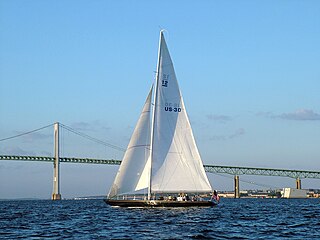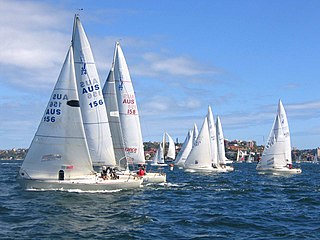
A catamaran is a multi-hulled watercraft featuring two parallel hulls of equal size. It is a geometry-stabilized craft, deriving its stability from its wide beam, rather than from a ballasted keel as with a monohull boat. Catamarans typically have less hull volume, smaller displacement, and shallower draft (draught) than monohulls of comparable length. The two hulls combined also often have a smaller hydrodynamic resistance than comparable monohulls, requiring less propulsive power from either sails or motors. The catamaran's wider stance on the water can reduce both heeling and wave-induced motion, as compared with a monohull, and can give reduced wakes.

Dinghy sailing is the activity of sailing small boats by using five essential controls:

Hobie Cat is a company that manufactures sailing catamarans, surfboards, sailboats, kayaks, stand-up paddle boards, and pedalboards as the Hobie Cat Company. It was founded in 1961 by Hobart Alter, who originally manufactured surfboards. Its line of products has included more than twenty sailing craft, plus a variety of other watercraft.

The 12 Metre class is a rating class for racing sailboats that are designed to the International rule. It enables fair competition between boats that rate in the class whilst retaining the freedom to experiment with the details of their designs. The designation "12 Metre" does not refer to any single measurement on the boat, and is not referencing the vessels overall length, rather, measures the sum of the components directed by the formula which governs design and construction parameters. Typically 12 Metre class boats range from 65 to 75 feet in length overall; they are most often sloop-rigged, with masts roughly 85 feet tall.

The A-Class Catamaran, often abbreviated to A-Cat, is a development class sailing catamaran for singlehanded racing.

The Formula 18 class, abbreviated F18, is a non-foiling, restricted development, formula-design sport catamaran class. It was started in the early 1990s and quickly grew getting class recognition by World Sailing, with large racing fleets all over the globe.

The Formula 16 (F16) sport catamaran is an ISAF recognised 5 m long beach catamaran with an asymmetric spinnaker setup.
The International Catamaran Challenge Trophy is the formal name for the match racing series between two catamarans familiarly known the Little Americas Cup. While a championship series sailed between C Class catamarans does still exist, it is no longer known as the Little America's Cup.
The International C-Class Catamaran Championship,, is a match racing sailing competition featuring the highly innovative International C-Class Catamarans, predominantly with a wingsail rather than conventional sail plan.
A mast-aft rig is a sailboat sail-plan that uses a single mast set in the aft half of the hull. The mast supports fore-sails that may consist of a single jib, multiple staysails, or a crab claw sail. The mainsail is either small or completely absent. Mast-aft rigs are uncommon, but are found on a few custom, and production sailboats.

A sailing hydrofoil, hydrofoil sailboat, or hydrosail is a sailboat with wing-like foils mounted under the hull. As the craft increases its speed the hydrofoils lift the hull up and out of the water, greatly reducing wetted area, resulting in decreased drag and increased speed. A sailing hydrofoil can achieve speeds exceeding double and in some cases triple the wind speed.

A sailing yacht, is a leisure craft that uses sails as its primary means of propulsion. A yacht may be a sail or power vessel used for pleasure, cruising, or racing. There is no standard definition, so the term applies here to sailing vessels that have a cabin with amenities that accommodate overnight use. To be termed a "yacht", as opposed to a "boat", such a vessel is likely to be at least 33 feet (10 m) in length and have been judged to have good aesthetic qualities. Sailboats that do not accommodate overnight use or are smaller than 30 feet (9.1 m) are not universally called yachts. Sailing yachts in excess of 130 feet (40 m) are generally considered to be superyachts.
The Dart 18 is a one-design 18-foot (5.5 m) long glassfibre sailing catamaran. It is designed to be sailed by two people and can achieve speeds of up to 20 knots. This is reflected in its Portsmouth Yardstick of 805 and D-PN of 76.3

High-performance sailing is achieved with low forward surface resistance—encountered by catamarans, sailing hydrofoils, iceboats or land sailing craft—as the sailing craft obtains motive power with its sails or aerofoils at speeds that are often faster than the wind on both upwind and downwind points of sail. Faster-than-the-wind sailing means that the apparent wind angle experienced on the moving craft is always ahead of the sail. This has generated a new concept of sailing, called "apparent wind sailing", which entails a new skill set for its practitioners, including tacking on downwind points of sail.

The sport of sailing involves a variety of competitive sailing formats that are sanctioned through various sailing federations and yacht clubs. Racing disciplines include matches within a fleet of sailing craft, between a pair thereof or among teams. Additionally, there are specialized competitions that include setting speed records. Racing formats include both closed courses and point-to-point contests; they may be in sheltered waters, coast-wise or on the open ocean. Most competitions are held within defined classes or ratings that either entail one type of sailing craft to ensure a contest primarily of skill or rating the sailing craft to create classifications or handicaps.
VPLP design is a French-based naval architectural firm founded by Marc Van Peteghem and Vincent Lauriot-Prévost, responsible for designing some of the world's most innovative racing boats. Their designs presently hold many of the World Speed Sailing records.

The AC72 is a class of wingsail catamarans built to a box rule, which governs the construction and operation of yachts competing in the 2013 Louis Vuitton and the America's Cup races. The class was subsequently replaced by the smaller AC50 class.
Nacra Sailing is a Dutch company that manufactures a line of small catamaran sailboats, or beachcats. NACRA was founded in 1975 to tap into the market created by Hobie Alter the founder of Hobie Cat, and several other companies offering small fiberglass catamarans designed to be sailed off the beach by a crew of one or two.

The International B-class/F20 Catamaran, is a development class, on the comeback after the fracturing of the original B-class, into the myriad of one design, off the beach cats we have today.

Miss Nylex is a C-Class racing catamaran, designed and built in Australia in the 1970s specifically to compete in the International Catamaran Challenge Trophy (ICCT). It has a single wingsail with two aerodynamic flaps, instead of the conventional mast and sail combination.














